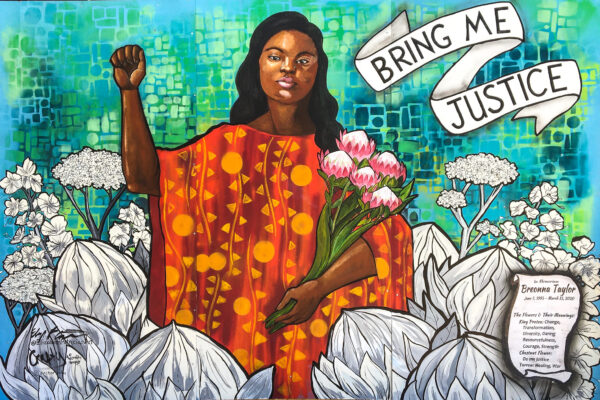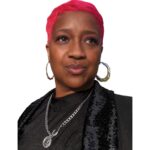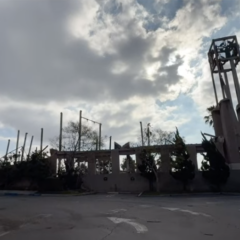This article was originally published by the Canopy Forum on the Interactions of Law & Religion.
I live in Los Angeles, California, near what seems to me to be one of the most dangerous intersections in South LA, Vermont and Gage. On any given day, the intersection looks like any other intersection in the city. But to live in this area is to know, there are underlying factors that make this intersection dangerous and, at times, even deadly. Some of those underlying factors are: poverty, gang activity, and an abundance of narcotics. To heal the intersection, we would need to address those underlying issues, individually and collectively.
The intersection of Black Women and the Law, is like the intersection where I live: dangerous and at times even deadly. In March of this year, in Louisville, Kentucky, 26-year-old emergency medical technician Breonna Taylor was murdered in her apartment by local police while asleep in her bed. But the law enforcement officers who killed her have not yet been arrested. It is becoming more and more clear that the underlying issues Black women face at the intersection with law enforcement are multifaceted and require a broader and deeper discussion, more than the surface review, as if these are isolated, rare occurrences. They are not, and there is something terribly wrong at this intersection; which is why I’ve made this case a personal focus.
An intersection is a point at which two or more things intersect. In a paper for the University of Chicago Legal Forum, Kimberle Crenshaw, originator of the term “intersectionality” wrote that traditional feminist ideas and antiracist policies exclude Black women, because they face a uniquely overlapping set of discriminations. As she described it, “Because the intersectional experience is greater than the sum of racism and sexism, any analysis that does not take intersectionality into account cannot sufficiently address the particular manner in which Black women are subordinated”. In 2015, Merriam-Webster added “intersectionality” to its dictionary, defining it as
the complex, cumulative way in which the effects of multiple forms of discrimination (such as racism, sexism, and classism) combine, overlap, or intersect especially in the experiences of marginalized individuals or groups.
My personal and moral interest in writing about this stems from my own experience. In 2018, my eldest son was shot and killed. It took the police less than 72 hours to arrest and charge my son’s killer. Those steps were paramount to our family being able to trust in and persevere through the subsequent legal process; it gave us the assurance that the work of justice was beginning for us and our son. As long as Breonna’s family and others are not given similar opportunities to seek due process against those who killed her, moving forward peacefully will be difficult.
It’s been nearly 140 days since Breonna Taylor was peacefully asleep in her bed, and tragically killed by the Louisville police. Beyond tragic is the fact that the officers who are responsible for taking a very innocent life, also falsified the initial report and failed to offer timely medical attention. And yet, they have to date not been held accountable. What desperately needs to be investigated is the system itself and the intersection where law enforcement and Black women fatally collide. Often leaving much to be desired and demonstrated in the way of true justice, the tragic reality is that these stories still go unnoticed and garner little to any national attention.
But Breonna Taylor refuses to be ignored, and in the midst of national outcry around Ahmaud Arbery and George Floyd, her spirit still speaks to us and so we Say Her Name. Breonna Taylor’s story reminds of the case of Aiyana Stanley-Jones, a seven-year-old girl, shot in her sleep by Joseph Weekley who a jury failed to convict in his second trial. How can a seven-year-old mean so little to a nation that claims freedom and justice for all? If one wanted to know about more of these kinds of stories, a good source would be the article #SayHerName Puts Spotlight on Black Women Killed by Police.
What I hope to do here is name the parts of this very messy intersection, so we begin to understand what we are facing. I hope that in doing so, I can help spark conversation around what it really looks like to bring justice to these grossly complex, unjust, and dangerous intersections. The failure of the system to move forward in arresting the persons who killed Breonna Taylor provides a shield for those officers. It is a shield we see raised over and over again. What the family of Breonna Taylor is experiencing and what we are witnessing is a gross miscarriage of justice at this intersection. We can no longer afford to pretend that it is an intersection like any other.
For too long, cases of Black and Brown women killed by police and those who have experienced intolerable brutality at their hands, have gone unnoticed or have received far less attention than others. We cannot afford any more Breonna Taylors. Taking her from her family and community created years of irreparable collateral damage that Black families and communities cannot afford.
If America thinks that systematic mistreatment of Black and Brown women can continue without serious correction and accounting, she is deeply mistaken. Demographics indicate a growing shift in the balance of power and influence that favors people of color. We see this shift with the #WomensMarch of 2018, in recent political battles where key seats are being won by women of color, and in the 140 plus days of protests that continue demanding for the killers of Breonna Taylor to be arrested.
So, let’s name who we find at this intersection.
First, we must name white supremacy at the center of this intersection. To be sure, not every cop is a white supremist; but the system and intersection itself is fueled by white supremist undercurrents that contribute to an ideological framework in which Black and Brown bodies are deserving of lesser treatment because those bodies are seen as less than human.
Also at this intersection is sexism; sexist prejudice that is often aimed at Black women, because they are female. Historically, Black women’s bodies have very often been seen as nothing more than tools or toys, from plantation workers to sex workers. Traces of this root grow from enslavement, and they sadly continue to permeate our 21st century context.
The intersection has in one corner the lack of access and another corner failure to protect. We know for sure that Breonna Taylor lived for up to five minutes after she was shot; yet she was not given immediate medical attention. This is indicative of the gross lack of access Black and Brown women have to mental health services, physical health attention, and other protective resources. Who on scene made the decision that Breonna didn’t need, or worse yet was undeserving, of immediate medical attention? Far too long, this has been a leading social justice battle that Black and Brown women face: Often, someone else, typically a collective of white males, decides our fate by not prioritizing access to medical attention.
At this intersection is patriarchy, a white male power patriarchy that collectively decides the fate of women, especially women of color. White male power has historically excused white males of their crimes related to women, especially Black and Brown women. White male power sees no crime here, when acts against immigrant, Indigenous, Black or Brown bodies occur. In the case of Breonna Taylor, authorities have reported that they are still trying to determine “what happened”; there is still a question as to whether there was a crime, wrongdoing, or error that took place here. But we already know that Breonna Taylor was killed in her apartment by Louisville Police while doing nothing more than sleeping in her bed. White male power also upholds the other culprit at this intersection: the blue code of silence.
The blue code of silence is an informal code of silence among police officers that encourages officers not to report on a colleague’s errors, misconducts, or crimes, including police brutality. There is no doubt law enforcement fatally erred in this case, however, including by falsifying initial reports, attempting to make Breonna’s boyfriend, Kenneth Walker the fall guy, and even going so far as to ask her mother if Breonna “had enemies.” Such errors are emblematic of this code of silence.
Most importantly to name at this intersection is Breonna Taylor, who represents too many Black and Brown women’s bodies whose families have yet to get justice. And we are still saying their names! In the words of Malcom X, “The most disrespected person in America is the Black woman. The most unprotected person in America is the Black woman. The most neglected person in America is the Black woman.” It is no surprise that Breonna Taylor’s case did not receive the notice and acknowledgement that the other cases have, but it does bring light to the intersection and highlights the scale of work that is needed as we pursue justice.
It is important to name who is at the intersection for the purpose of accountability and true systemic transformation. We cannot hold accountable the real cause of the danger or fatality at the intersection if we cannot or do not identify and name each issue independently and then call for change collectively. For a number of people that I’ve spoken with on panels and discussion groups, who are not readily engaged in justice movement activities, their perception of a case like Breonna Taylor’s is, it’s just one “accident”, incident, or an independent moment. They don’t see the deeper issues at play at the intersection. What is needed here, however, is a deep unpacking and deconstructing of these intersections, so that we are able to raise the complexities of the injustices and hold the perpetrators fully accountable and achieve greater justice.
Read the article on canopyforum.org.
Photo credit: Annette Bernhardt / Flickr
Rev. Najuma Smith is Assistant Director of Community and Public Engagement with the USC Center for Religion and Civic Culture.






